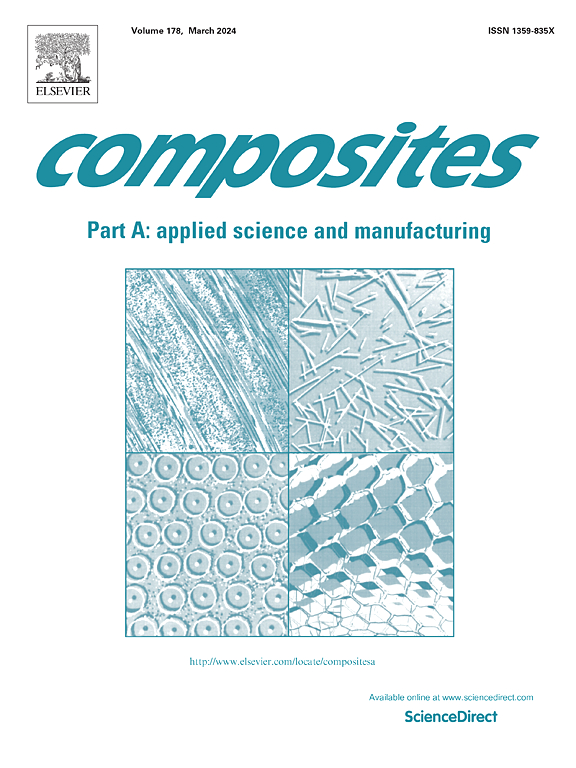带纤维转向的 3D 打印伪编织 CFRP 复合材料螺栓连接的轴承性能和渐进失效分析
IF 8.1
2区 材料科学
Q1 ENGINEERING, MANUFACTURING
Composites Part A: Applied Science and Manufacturing
Pub Date : 2024-10-15
DOI:10.1016/j.compositesa.2024.108526
引用次数: 0
摘要
本研究调查了三维打印伪编织碳纤维增强聚合物(CFRP)复合材料接头的轴承失效过程,尤其关注受转向纤维影响的损坏机制。采用 LaRC05 失效标准开发了一个多尺度有限元模型,并根据四种不同情况的实验载荷-位移曲线和显微计算微断层扫描(CT)图像进行了验证。该模型清楚地表明,保持螺栓孔周围纤维的连续性至关重要,因为这极大地影响了减少螺栓直接承载载荷引起的应力集中的能力。此外,该模型还揭示了纤维转向可大幅提高复合材料接头的性能。这种改善是通过调整单根纤维中剪切引起的损伤传播水平实现的。结果表明,该模型具有捕捉单根纤维行为的潜力和能力,可用于 3D 打印复合材料的失效分析,在失效模式和承载能力方面与实验测量和观察结果具有良好的相关性。本文章由计算机程序翻译,如有差异,请以英文原文为准。
Bearing performance and progressive failure analysis of bolted joint in 3D printed pseudo-woven CFRP composite with fibre steering
This study investigates the bearing failure process of 3D printed pseudo-woven carbon fibre reinforced polymer (CFRP) composite joints, with a particular focus on the damage mechanisms influenced by steered fibres. A multiscale finite element model employing LaRC05 failure criteria is developed and validated against the experimental load–displacement curves and micro-computed microtomography (CT) images of four distinct cases. The model clearly demonstrates the critical importance of maintaining fibre continuity around the bolt hole, as this significantly influences the ability to reduce stress concentrations caused by the direct bearing loads from the bolt. Moreover, the model reveals that fibre steering can substantially improve the composite joint’s performance. This enhancement is achieved by adjusting the level of shear-induced damage propagation in individual filaments. The results demonstrate the potential and capability of the model to capture individual filament behaviour for the failure analysis of 3D printed composites, achieving good correlations with experimental measurements and observations, in terms of failure modes and load-bearing capacities.
求助全文
通过发布文献求助,成功后即可免费获取论文全文。
去求助
来源期刊

Composites Part A: Applied Science and Manufacturing
工程技术-材料科学:复合
CiteScore
15.20
自引率
5.70%
发文量
492
审稿时长
30 days
期刊介绍:
Composites Part A: Applied Science and Manufacturing is a comprehensive journal that publishes original research papers, review articles, case studies, short communications, and letters covering various aspects of composite materials science and technology. This includes fibrous and particulate reinforcements in polymeric, metallic, and ceramic matrices, as well as 'natural' composites like wood and biological materials. The journal addresses topics such as properties, design, and manufacture of reinforcing fibers and particles, novel architectures and concepts, multifunctional composites, advancements in fabrication and processing, manufacturing science, process modeling, experimental mechanics, microstructural characterization, interfaces, prediction and measurement of mechanical, physical, and chemical behavior, and performance in service. Additionally, articles on economic and commercial aspects, design, and case studies are welcomed. All submissions undergo rigorous peer review to ensure they contribute significantly and innovatively, maintaining high standards for content and presentation. The editorial team aims to expedite the review process for prompt publication.
 求助内容:
求助内容: 应助结果提醒方式:
应助结果提醒方式:


